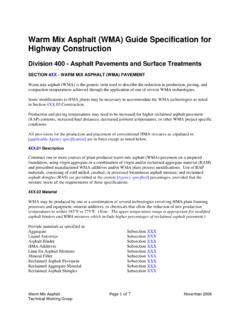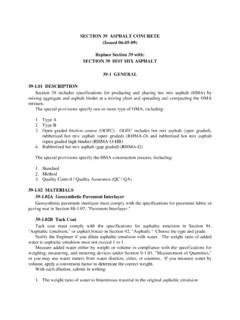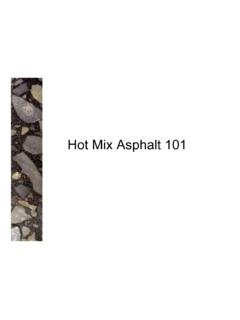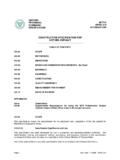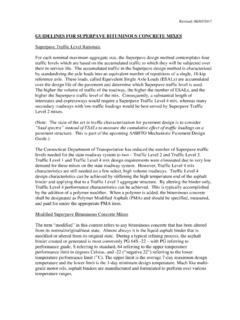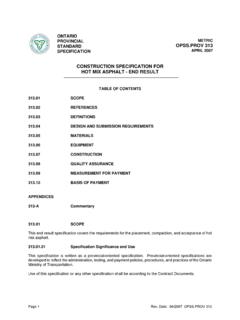Transcription of P401 Hot Mix asphalt (HMA) Structural Lift …
1 AC 150/5370-10G P401/P403 Lift thickness January 20, 2016 P401 Hot Mix asphalt (HMA) Structural Lift thickness vs construction Lift thickness Discussion and Recommendation Structural thickness of HMA needed, may not always equal lift thickness of HMA to be constructed. There are times when the construction lift thickness may need to be thicker than what is required structurally for constructability reasons. HMA with modified PG binders combined with angular aggregates and less natural sand may require thicker lifts than what may have been used in the past. In AC 150/5370-10G Item P401 paragraph , In the note to engineer above Table 3 Aggregate HMA Pavements, it is recommended that the aggregate size be no greater than the lift thickness to be constructed.
2 This indicates a minimum lift thickness at least 4 x the largest actual particle size; which can generally be considered 4 x nMAS (nominal Maximum Aggregate Size = one size larger than the first sieve to retain more than 10 percent of material). Engineering judgment will be required when developing project to make sure that design can be constructed. Using this guideline the following minimum lift thicknesses are recommended: FAA Gradation 1 3 inches FAA Gradation 2 2 inches FAA Gradation 3 1 inches In the note to engineer below Table 3 Aggregate HMA Pavements, it states The Engineer is only to specify Gradation 3 for leveling course, airfield shoulders, and roadways.
3 When choosing which gradation to use we recommend keeping minimum lift thickness to 4 x nMAS. However this is a recommendation, not a requirement. It is never recommended to use a lift thickness less than 3 x nMAS; and generally want to keep maximum lift thickness less than 6 x nMAS. Thinner lifts require that compaction be completed sooner, thus rollers must be closer to paver and may require more rollers to complete compaction before lift has cooled. When developing the scope of the project these are the type of items that should be addressed in the engineers report. See example case studies on next page. The figure shown below, from NCAT NCHRP Report 531, shows the relationship between lift thickness and air voids for a Gradation 1 mix.
4 AC 150/5370-10G P401/P403 Lift thickness January 20, 2016 Example Cases New construction : FAARFIELD gives the Structural pavement thickness needed to support the Aircraft Traffic. For new construction it is up to the designer to designate what gradation to use based upon materials available. For example if the pavement design requires: 4 P401 / 5 P403 / 12 P209; If using Gradation 1 P209 placed in 2 lifts of 6 , P403 in one lift of 5 , P401 placed in 1 lift of 4 If using Gradation 2 P209 in 2 lifts of 6 , P403 in 2 lifts of 2 , P401 in 1 lift of 4 or 2 lifts of 2 If using Gradation 3 Cannot use Gradation 3 Rehabilitation: For rehabilitation it is also up to the designer to designate what gradation to use based upon thickness of overlay and materials available.
5 If project is not to strengthen RW but rather is a rehabilitation of the existing wearing surface, the designer must evaluate condition and amount of each existing material in pavement structure, combined with evaluation of grades, drainage, NAVAIDS & in pavement lighting. The designer can then determine how much existing pavement structure must be removed prior to installation of the new wearing surface. Generally, milling thickness needs to either leave at least 2 of existing surface li ft thickness or entire lift should be removed (This is to avoid having thin sections remaining which are prone to deterioration under construction loads).
6 Then the designer must evaluate between: (1) overlay the existing surface; or (2) remove a portion of existing surface, (3) all of the existing surface or (4) the entire existing surface plus some base. The condition of the existing surface and base combined with evaluation of all of the other factors will drive what is the best solution. Once the designer determines what thickness of material is to be removed combined with how much material will be added, this will drive what gradation will be specified (and acceptable lift thicknesses). For example consider an existing pavement structure that consists of: 3 P401 / 5 P403 / 12 P209 Some of the options for rehabilitation of wearing surface may include.
7 Option 1 (assuming P401 in good condition) Mill 1 existing P401, Overlay with 2 of P401 Gradation 2 Option 2 (assuming P401 in fair condition) Mill 3 of existing P401, Overlay with 3 P401 Gradation 1 Option 3a (assuming P401 in fair condition and need to correct profile) Mill 4 of existing P401/P403, Overlay with 2 -2 lifts of P401 Gradation 2 Option 3b (assuming P401 in fair condition and need to correct profile) Profile mill 4 of existing P401/P403, Overlay with 1 lift of P401 Gradation 1 Bottom Line: When choosing which gradation to use FAA HQ AAS100 recommends keeping construction lift thickness to at least 4 x nMAS.
8

